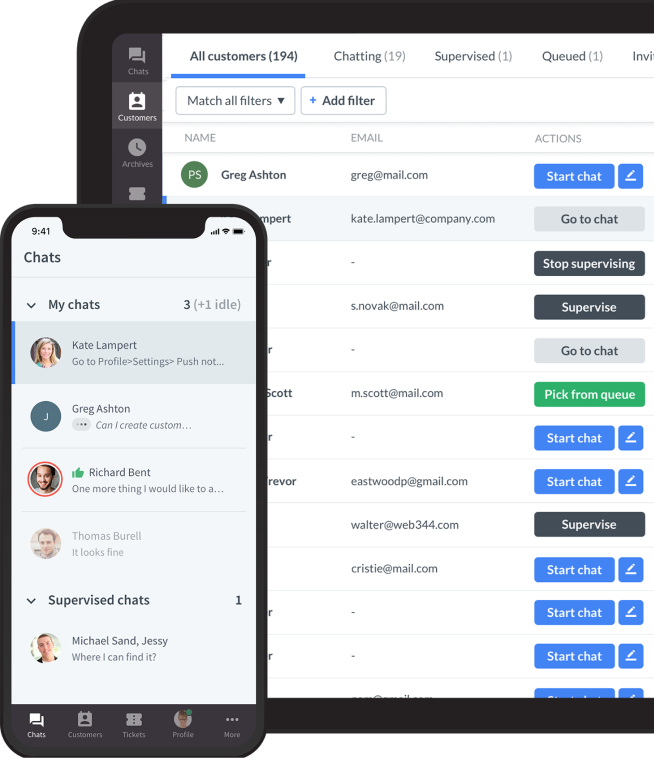
TL;DR Customer service in 2025 isn’t human or automation — it’s both. AI handles the routine, humans bring empathy. Learn the trends, frameworks, and tools like Text App that help support teams scale without losing their personal touch.
***
It’s 11:30 PM and your customer wants to know where their package is.
A few years ago, that request would sit unanswered until morning, stacked with dozens of others. Today, AI can pull the tracking number, update the order, and send the reply in seconds. But here’s the catch: when the same customer writes back saying it’s a birthday gift that still hasn’t arrived, empathy matters more than automation.
That’s the paradox of customer service in 2025: speed is expected, but humanity is remembered.
This article explores how automation is reshaping support, why humans still play an irreplaceable role, and which tools (like Text App) make it possible to deliver both.
Why support feels different in 2025
Support leaders are feeling the squeeze.
Customers want instant answers on every channel, from email to Instagram DMs. Budgets aren’t growing, but ticket volumes are. And the old “chatbot vs. human” debate feels outdated — customers expect both.
AI has matured beyond the scripted chatbot. Today’s tools can act: resetting passwords, issuing refunds, booking services, and escalating seamlessly when nuance is required.
That evolution changes the job of support teams, and it’s why this moment matters.
Trends shaping customer service
I often hear leaders say, “We’re not sure where to lean in: more automation, or more people?”
The reality is that the biggest shifts are happening at the intersection:
-
AI-first platforms – no longer bolt-ons, but core to how service runs.
-
Blended experiences – a smooth handoff between bot and human (customers don’t care who helps them, as long as it works).
-
Omnichannel expectations – support that follows the customer, not the other way around.
-
Personalization at scale – AI trained on your own knowledge base, not just generic FAQs.
-
Customer preferences – surveys show most people are fine with AI for quick fixes, but they want a human when the issue gets personal.
The trend line is clear: the winners are blending automation with humanity, not choosing one side.
What still matters today
Some things about customer service have changed beyond recognition. But others remain stubbornly constant. No matter how advanced automation becomes, these truths will always sit at the center of a great experience.
Empathy still wins the moment
A chatbot can track a package. But when a customer says the missing package contained their child’s birthday gift, the tone matters more than the tracking link. That’s where humans step in. Empathy isn’t a “nice-to-have.” It’s the piece that transforms a transaction into a relationship. Customers may forgive mistakes, but they don’t forget how you made them feel.
Trust is non-negotiable
The quickest way to lose a customer is to make them doubt you. People want to know who they’re talking to — AI or human — and they want consistency between what you promise and what you deliver. Transparency isn’t a buzzword here; it’s currency. When your systems are clear and your automation behaves predictably, confidence follows.
Reliability beats sophistication
It doesn’t matter how clever your AI sounds if it drops the ball on simple tasks. Reliability is the quiet force that keeps customers coming back. A bot that gets order details right every time builds more loyalty than one that dazzles with witty replies but stumbles on basics. Put differently: better to be boring and dependable than flashy and flaky.
Agent experience shapes customer experience
If your automation makes life harder for agents, it will make life harder for customers too. Clunky dashboards, confusing handoffs, and fragmented tools add friction instead of removing it. The best systems don’t just support customers — they support the people helping those customers. A streamlined workspace that blends automation with intuitive controls keeps morale high and service smooth.
Where automation helps most
Not every part of customer service needs a human touch. In fact, most of what fills your support queue is routine, repetitive, and draining for agents. That’s where automation doesn’t just help— it shines.
Repetitive queries, solved instantly
-
“Where’s my order?”
-
“How do I reset my password?”
-
“What’s your refund policy?”
These questions make up a huge chunk of support volume. AI can handle them in seconds, with zero frustration on the customer side. And for agents, it means fewer déjà vu tickets and more time for conversations that actually require thought.
Smarter ticket routing
Think about the wasted time when a billing issue gets sent to technical support, or a VIP’s email sits unnoticed in a general inbox. Automation fixes that. By tagging, prioritizing, and routing tickets correctly, AI ensures the right person sees the issue right away. Customers feel heard faster, and your team avoids the endless shuffle.
Proactive knowledge sharing
Sometimes the best answer is the one customers find themselves. Automation can surface knowledge base articles, suggest quick fixes, or even guide people through step-by-step resolutions. This kind of self-service doesn’t replace your team — it empowers customers to solve easy problems on their own, while freeing agents to handle the edge cases.
Scaling without extra headcount
Every holiday season, ticket volume spikes. Every product launch brings a flood of “how do I…” questions. Hiring more agents for a few weeks isn’t realistic. Automation absorbs these surges without burning out your team. AI agents don’t get tired, and they don’t take vacation. They scale up instantly, so you stay responsive even when demand doubles overnight.
Humanized automation in action
This balance isn’t theoretical. Tools like Text App were designed for it.
Inside one workspace, teams can:
-
Chat live with customers.
-
Manage support tickets across email and social.
-
Deploy AI agents that resolve issues automatically.
What makes Text different is the AI-first approach. Its agents aren’t “add-ons” — they’re trained on your own data and Knowledge hub, so they answer accurately and know when to hand off to a human. That means midnight order checks get solved in seconds, while birthday-gone-wrong messages get escalated to a person who can show empathy.
It’s automation with guardrails. Customers feel cared for, and teams stay efficient.
Tools to consider in 2025
Text isn’t the only player. Here’s how the landscape looks right now:
|
Tool |
Strength |
Best for |
|
Text App |
Unified AI-first platform with live chat + helpdesk |
Teams wanting one workspace that scales |
|
Zendesk |
Deep ticketing workflows + integrations |
Large enterprises, compliance-heavy ops |
|
Intercom |
Conversational, real-time messaging with AI |
SaaS and tech startups that value proactive support |
|
Freshdesk |
Affordable, all-in-one helpdesk |
Small businesses on a budget |
|
Kustomer |
Customer timeline + CRM-like features |
Mid-market teams needing personalization |
|
Tidio |
Simple, chat-first with affordable AI |
Small ecommerce and startups |
The right tool isn’t about who has the flashiest AI. It’s about fit: which one helps your team solve today’s pain without creating new ones.
Framework for choosing the right mix
The temptation is to chase shiny features. But the smarter move is to pause and ask the right questions. Choosing the right balance of automation and human service isn’t about who has the most AI widgets — it’s about fit. Here’s a framework that brings clarity:
Which tasks overwhelm your team right now?
Look at your backlog. Is it password resets, shipping updates, or product returns? These are prime candidates for automation. If the bulk of your team’s time is spent on issues that could be solved without human judgment, that’s where AI should step in first.
Can automation cover them without breaking trust?
Just because something can be automated doesn’t mean it should. Customers are comfortable with AI for routine tasks, but when the stakes are personal—billing disputes, health-related questions, or sensitive complaints — a human touch is essential. The line is simple: automate where trust won’t be compromised.
Does the tool unify or fragment your workflow?
One of the biggest risks in adopting new software is creating yet another silo. If your automation lives outside your main support channels, it creates confusion for agents and customers alike. The right solution pulls everything into one view — chat, email, social, tickets — so context isn’t lost along the way.
Does the AI act, or just suggest?
There’s a world of difference between an AI that drafts a response and one that actually issues the refund, updates the CRM, or resets the password. The former saves a few seconds; the latter transforms your capacity. Look for tools that don’t just talk, but take action.
If you can tick “yes” on these questions, you’re already closer to a healthy balance — one where automation absorbs the repetitive load and humans focus on the moments that build loyalty.
Conclusion
The future of customer service isn’t human versus automation. It’s human with automation. The companies winning in 2025 are those who see AI not as a replacement, but as a partner.
Text App was built with this philosophy in mind: let automation handle the routine, so your team can focus on what really matters.
If you’re ready to see the balance in action, start a free trial of Text App today.
FAQ
Is automation going to replace human customer service agents?
No. Automation handles repetitive, routine requests so your team can focus on complex or sensitive issues. The best results come from combining both.
What kind of tasks are best suited for automation?
Think high-volume, low-complexity: order status, password resets, ticket routing, FAQs. These are areas where AI can deliver instant answers without risk.
Will customers trust AI responses?
Customers trust AI when it’s reliable and transparent. If it solves their problem quickly, they don’t mind who’s behind the reply — so long as they know a human is there if needed.
How do I know if I’m over-automating?
If customers start asking to “speak to a human” too often, or if your agents are spending more time fixing bot mistakes than helping people, you’ve gone too far.
What makes Text App different from other automation tools?
Text App is built AI-first. Its agents aren’t bolted-on bots — they act on your behalf using your own knowledge base and customer data, while escalating gracefully when nuance is needed.
Is automation affordable for small businesses?
Yes. Tools like Text App are designed with flexible pricing so even small teams can introduce automation without breaking the budget.



